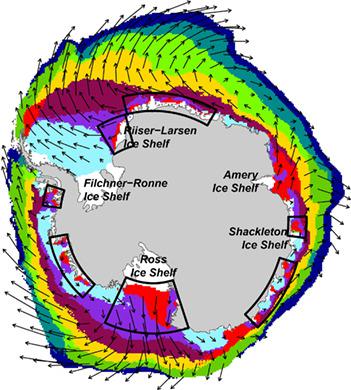当前位置:
X-MOL 学术
›
Int. J. Climatol.
›
论文详情
Our official English website, www.x-mol.net, welcomes your
feedback! (Note: you will need to create a separate account there.)
A new approach to classification of 40 years of Antarctic sea ice concentration data
International Journal of Climatology ( IF 3.5 ) Pub Date : 2020-10-09 , DOI: 10.1002/joc.6874 Paul Wachter 1 , Fabian Reiser 2 , Peter Friedl 3 , Jucundus Jacobeit 4
International Journal of Climatology ( IF 3.5 ) Pub Date : 2020-10-09 , DOI: 10.1002/joc.6874 Paul Wachter 1 , Fabian Reiser 2 , Peter Friedl 3 , Jucundus Jacobeit 4
Affiliation

|
In this paper, we present a characterization of Antarctic sea ice based on the classification of annual sea ice concentration (SIC) data from 1979 to 2018. A clustering algorithm was applied to provide a climatological description of significant annual cycles of SIC and their spatial distribution around the Southern Ocean. Based on these classification results, we investigate the variability of SIC cycles on decadal and inter‐annual time scales. First, we discuss significant spatial shifts of SIC cycles during 1979–1998 and 1999–2018. In the Weddell Sea and in large parts of the Ross Sea, we observed higher SIC during the summer season, and an extension of sea ice cover in winter compared to the long‐term average. Second, we introduce the Climatological Sea Ice Anomaly Index (CSIAI), which is an annual measure for year‐round sea ice anomalies of the Southern Ocean and its regional sub‐sectors. By relating selected years of significant sea ice conditions (1981, 2007 and 2014) with atmospheric influences, we demonstrate that the CSIAI is very useful for assessing inter‐annular Antarctic SIC variability. Positive and negative sea ice anomalies can be qualitatively explained by atmospheric circulation anomalies in the years 1981 and 2007. However, in 2014, the year with the largest observed sea ice extent in our time series, we found that this positive sea ice anomaly was surprisingly not associated with a stationary and inter‐seasonally persistent pattern of circulation anomaly. This suggests that sub‐seasonal to seasonal circulation anomalies and ocean‐related processes favoured the formation of the sea ice maximum in 2014. With this study we provide additional information on the long‐term annual SIC variability around Antarctica. Furthermore, our classification approach and its results have potential for application in the evaluation of sea ice model results.
中文翻译:

一种分类40年南极海冰浓度数据的新方法
在本文中,我们基于1979年至2018年的年海冰浓度(SIC)数据分类,提出了南极海冰的特征。使用聚类算法提供了重要的SIC年度周期及其空间分布的气候学描述。在南大洋周围。基于这些分类结果,我们研究十年和年际时间尺度上SIC周期的变异性。首先,我们讨论了1979-1998年和1999-2018年SIC周期的重大空间变化。与长期平均水平相比,在韦德尔海和罗斯海大部分地区,我们观察到夏季的SIC较高,冬季的海冰覆盖范围有所延长。其次,我们介绍了气候海冰异常指数(CSIAI),这是对南大洋及其区域子行业全年海冰异常的年度测量。通过将选定的重大海冰条件年份(1981、2007和2014)与大气影响相关联,我们证明了CSIAI对于评估南极环南SIC变异性非常有用。从1981年和2007年的大气环流异常可以定性地解释正负海冰异常。但是,在2014年(在我们的时间序列中观测到的海冰范围最大的一年),我们发现这种正海冰异常令人惊讶地与循环异常的平稳和季节间持续模式无关。这表明亚季节到季节环流异常以及与海洋有关的过程有利于2014年形成最大的海冰。通过这项研究,我们提供了有关南极周围长期SIC年度变化的更多信息。此外,我们的分类方法及其结果在海冰模型结果评估中具有潜力。
更新日期:2020-10-09
中文翻译:

一种分类40年南极海冰浓度数据的新方法
在本文中,我们基于1979年至2018年的年海冰浓度(SIC)数据分类,提出了南极海冰的特征。使用聚类算法提供了重要的SIC年度周期及其空间分布的气候学描述。在南大洋周围。基于这些分类结果,我们研究十年和年际时间尺度上SIC周期的变异性。首先,我们讨论了1979-1998年和1999-2018年SIC周期的重大空间变化。与长期平均水平相比,在韦德尔海和罗斯海大部分地区,我们观察到夏季的SIC较高,冬季的海冰覆盖范围有所延长。其次,我们介绍了气候海冰异常指数(CSIAI),这是对南大洋及其区域子行业全年海冰异常的年度测量。通过将选定的重大海冰条件年份(1981、2007和2014)与大气影响相关联,我们证明了CSIAI对于评估南极环南SIC变异性非常有用。从1981年和2007年的大气环流异常可以定性地解释正负海冰异常。但是,在2014年(在我们的时间序列中观测到的海冰范围最大的一年),我们发现这种正海冰异常令人惊讶地与循环异常的平稳和季节间持续模式无关。这表明亚季节到季节环流异常以及与海洋有关的过程有利于2014年形成最大的海冰。通过这项研究,我们提供了有关南极周围长期SIC年度变化的更多信息。此外,我们的分类方法及其结果在海冰模型结果评估中具有潜力。











































 京公网安备 11010802027423号
京公网安备 11010802027423号